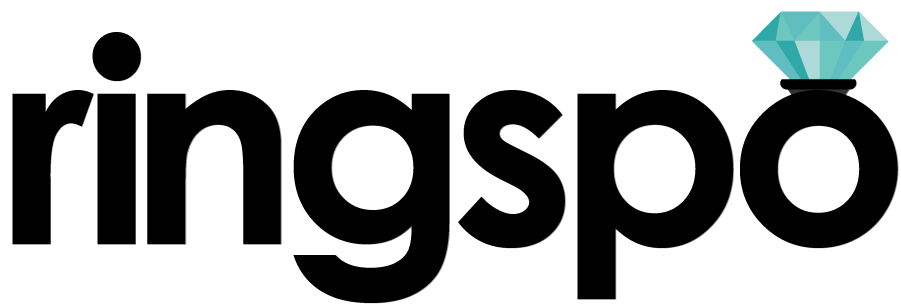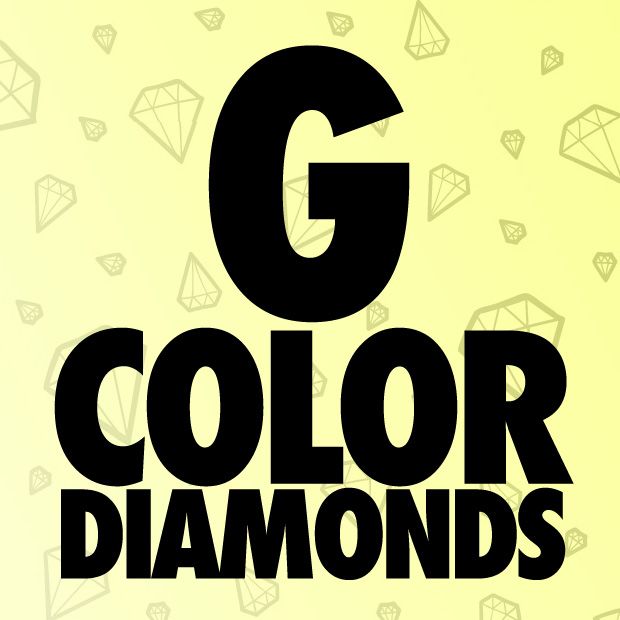G color diamonds
What you really need to know about G color diamonds
Ringspo is reader supported
Ringspo is reader-supported, which means we may receive a commission if you click a link to a retailer & subsequently make a purchase.
We feature links to several retailers to help readers find the one that is the best fit for them. Find out more about how Ringspo works here.
On this page we’re going to look at G color diamonds in detail, to help you decide whether a G color stone is right for you.
You’ll learn:
- What G color diamonds look like
- Whether G color diamonds look white or yellow
- How much a G color diamond will cost
- What G color looks like in different diamond shapes.
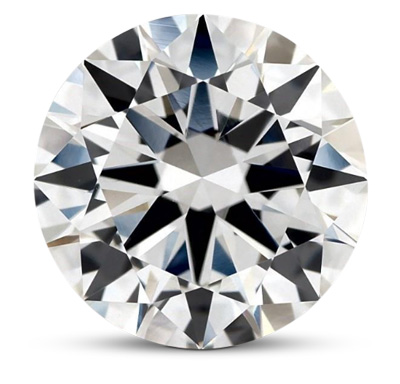
Finding the diamond that is right for you
Unlike when trying to find where to sell a diamond ring, the key to buying a good diamond depends less on the retailer and more on getting the balance of quality right.
When buying a diamond, it’s all about finding the right balance of the different qualities that are right for you. The one area that I always recommend people don’t scrimp on is the diamond cut grade, as this is the key factor in determining how much a diamond sparkles.
Then clarity (the diamond should be eye clean with no visible imperfections), then color (looking for a white appearance, without over-paying for color grades that don’t make any difference to how the diamond looks), and then the maximum carat weight that is possible within the budget.
A G color graded diamond is a great compromise between color and cost without sacrificing the beauty and sparkle for which diamonds are known.
G color diamonds and the color scale
The body color of the diamond is the determiner of whether the diamond sparkles with a cool white or ‘warmer’ tone. White diamonds are rarer, and as a result are the most expensive, while warmer-colored diamonds are more common and are priced lower.
Color is one of the most important of the 4Cs simply because you can see how yellow or white a diamond is with an unaided eye. In fact, gemologists grade the color of diamonds with just that – their eyes and a special light that simulates natural sunlight.
When judging the color of a diamond, a gemologist will place it upside-down, with the pavilion (the pointy bottom of a diamond) facing up, and examine it from the side. This makes it easier to judge the true color of the diamond.

When examining a diamond from the ‘face up’ position (how it is seen when set into a ring), the brilliancy, dispersion, and scintillation of the diamond (the sparkle) can trick the eye making the diamond appear whiter than it truly is. However, that sparkle is only achieved when the diamond is face up, so by flipping the diamond, color graders can judge the diamond’s body color more accurately.
G color diamonds and the color scale
The GIA color grade scale is the global industry standard and despite it being the 7th letter of the alphabet, G color diamonds are actually the 4th color letter grade.
They’re also the first grade in the ‘near colorless’ category, just one step away from ‘colorless’. Despite the name ‘near colorless’, a G color diamond will face up white.
And, because it’s not in the top ‘colorless’ category it is priced lower in price than a colorless stone. If you like the looks of the diamonds in the colorless category, but feel they are outside of your budget, then a G color grade diamond is the perfect buy.

The slight variation in color between individual grades is difficult to discern to the untrained eye and nearly impossible when looking at a lone diamond.
When shopping online, slide images of diamonds side by side to get a feel for the differences between the variations of white and warmer grades.
Seeing a color difference between a D color diamond and E color diamond will be difficult, but seeing a difference between a D and a J will be easy. Even without any prior diamond research, most people can spot the warmth of the J color immediately.
While diamonds are color graded side by side and diamonds are often shopped side by side, engagement rings are worn with a lone diamond. Keep this in mind and remember to look at the diamond on its own after comparing it. You may be able to see the difference between a D and a G when side by side, but evaluate the G alone and, I assure you, it will glisten with icy white fire.
What do G color diamonds look like?
G diamonds are very nearly colorless and, once mounted into a setting, will look as white as a D, E, or F color diamond. Remember, diamonds are assigned their color grade when upside down because the sparkle masks their body color. When they are face up, the color variations are hard to differentiate even for a professional. Luckily, most women do not wear their engagement rings with the diamonds upside-down!
The first image is of a G color diamond face up and the same diamond from the side. The second image is of a D color diamond face up and from the side. In the face up position, the slight warmth of the G diamond is impossible to see thanks to the masking abilities of the diamond’s scintillation and sparkle. Other than the price, the D and the G are virtually impossible to differentiate.
When viewed from the side though, the difference in color is much easier to detect.
Do G color diamonds look white?
As we’ve seen, a G color diamond will face up very white.
If there is visible yellow, the diamond is graded incorrectly. Ask to see the diamond’s accompanying diamond report and be sure it’s from GIA or AGS. Other grading labs can be less stringent with their grading of diamonds – to the point of assigning grades two to three grades higher than they would be from GIA or AGS.

A diamond graded as ‘G color’ by another lab may be graded as an ‘I’ color by GIA and AGS. While it may seem like you are getting more for your money by choosing a different lab, the reality is often that you are simply receiving a lower quality diamond and paying too much for it.
Do G color diamonds look yellow?
While G color diamonds are technically in the ‘near colorless’ range of color grading, these diamonds will appear colorless when viewed face up.
Warmer tones in near colorless diamonds may be detected when viewed upside down or from the side. However, when viewed from the top, the diamond’s brilliance will mask body color. Once the G color diamond is mounted into a white metal ring setting, differentiating it from a diamond graded ‘colorless’ will be almost impossible.
G color diamonds and setting color
One thing to keep in mind when choosing our diamond is the mounting that the diamond will be set into. A white metal mounting will help the diamond appear whiter, while a yellow gold mounting will make warmer body color more noticeable.
A G color diamond will look great in a white gold or platinum mounting.
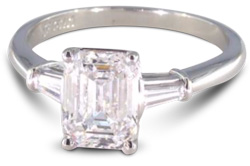
If the setting you are looking at includes pave diamonds, these are typically F, G or H color grade diamonds, which will complement the G color center diamond nicely.
G color diamonds vs. F and H color diamonds
Difference between F color and G color diamonds
F and G color diamonds will be almost impossible to distinguish even when compared side by side. In fact, when viewed face up, a gemologist will have a difficult time differentiating between the F in the colorless range and the G in the near colorless range. After all, there is only one color grade difference between them and, as we reviewed, the diamond’s brilliance will mask any warmth in body color. Once the diamond is mounted in a setting designed to display its fiery brilliance, the warmth will be undetectable.
However, the F color diamond is the last color grade in the ‘colorless’ category while the G color diamond is the first color grade in the ‘near colorless’ category. This difference in classification is more a psychological difference than anything else and even though the color variation is slight, the price difference could be significant.
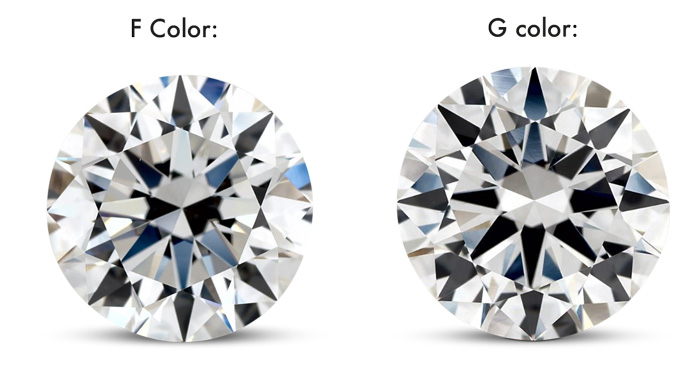
The first picture is an F color diamond and the second is the G color. Face up, there is very little difference, but you will see a difference in the price. Once set in the mounting, the G will be virtually indistinguishable from the F, but you will have saved a significant amount.
Difference between G color and H color diamonds
G and H color diamonds are one color grade apart with G being the higher grade and, therefore, whiter. However, both diamonds are in the same category of ‘near colorless’ which means there will only be a slight difference in price.
The G color diamond is on the left and the H color diamond is on the right. Face up, the diamonds look almost the same. Usually, people start detecting color in a diamond at the J range.
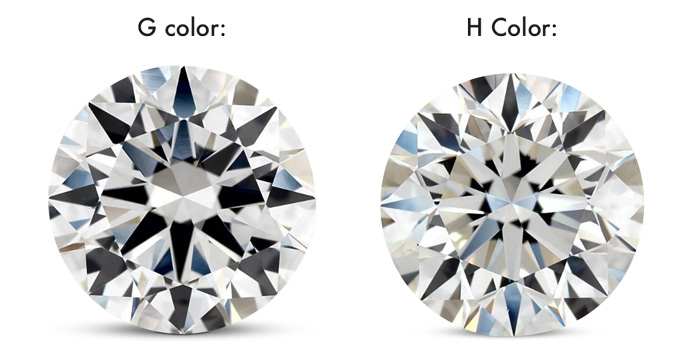
G color diamonds pricing and value
How much does a G color diamond cost?
As mentioned before, G color diamonds deliver a great blend of white color and price. Their price will depend on the other factors in the stone, but a 1 carat G color diamond with excellent cut and eye clean clarity could range from under $6,000 for a VS2, to nearly $8,000 for an internally flawless stone.
To show how G color diamonds compare to other colors, I looked at an average price on one of my recommended retailers, for every color.
Constants:
- Carat weight – 1.00 carat
- Clarity – VS2
- Cut – Excellent
| Color | Price (USD) | Difference (USD) | Difference (%) |
|---|---|---|---|
| D | $6,950 | $0 | 0% |
| E | $6,620 | -$330 | -4.7% |
| F | $6,410 | -$540 | -7.8% |
| G | $5,940 | -$1,010 | -14.5% |
| H | $5,480 | -$1,470 | -21.2% |
| I | $5,020 | -$1,930 | -27.8% |
| J | $4,380 | -$2,570 | -37.0% |
You can check today’s prices yourself here.
Notice on the table how there’s a few hundred dollars difference between the colorless grades E and F, but there is a much larger drop of $450 between the ‘colorless’ grade F and the ‘near colorless’ grade G.
The difference between these color grades F and G is extremely difficult to detect, but the difference to your wallet is much easier to notice!
G color diamonds and diamond shape
While so far we have used round brilliant diamonds for our examples, there are many other shapes available.
Rough diamonds are cut into a shape dictated by its crystal structure as well as a shape that highlights the diamond’s attributes.
A diamond crystal normally looks like two pyramids stuck together at their bases:
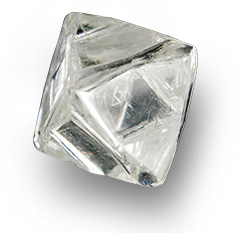
This shape naturally lends itself to yield two round diamonds. However, diamonds travel a turbulent and brutal path to the earth’s surface and sometimes rough diamond crystals become misshapen. Diamond cutters salvage the crystal by cutting it into a shape other than two round diamonds. These other shapes are called ‘fancy’ shapes – marquise, oval, pear, princess, radiant, cushion, asscher, emerald, and heart
One of the good things about fancy shapes is that they are usually less expensive than round diamonds. Fancy shapes also have a tendency to gain and fade in popularity throughout the years as they go in and out of fashion. Shapes that aren’t trending can be even less expensive.
G color round brilliant diamond
The round brilliant cut is the most popular and enduring diamond cut. It’s the cut that produces the most sparkle, brilliance, and fire, which can mask diamond color and make them appear whiter than their color grade.

A ‘brilliant cut’ diamond is a diamond that is cut and polished with numerous flat surfaces, or ‘facets,’ which produce the maximum light return. Regardless of shape, diamonds are fashioned with facets arranged in a brilliant cut pattern or in a step cut pattern. Step cut diamonds have facets that are long, parallel rows.
G color oval diamond
The oval cut diamond is an elongated round. Oval diamonds have a little bit less sparkle than the round and as a result can show a diamond’s color more than the round. This is most noticeable at either end of the stone – the body color has a tendency to pool at the tips of the diamond.
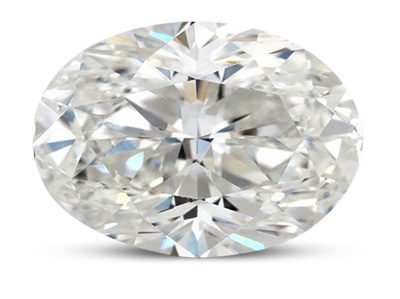
Despite this, G color is a good choice for an oval diamond and will still look white
G color princess cut diamond
The princess cut diamond is a square cut diamond with 4 pointed corners. Princess cuts have less sparkle than the oval and as a result can show a diamond’s body color more, with the body color pooling at the pointed corners. This could be a major factor in diamonds smaller than a carat that don’t have much area between the corners.
For diamonds of around 1 carat or more, G color is a good option. For diamonds significantly smaller than 1 carat, it may be a good choice to choose an F color stone to ensure that no warm tones are visible.
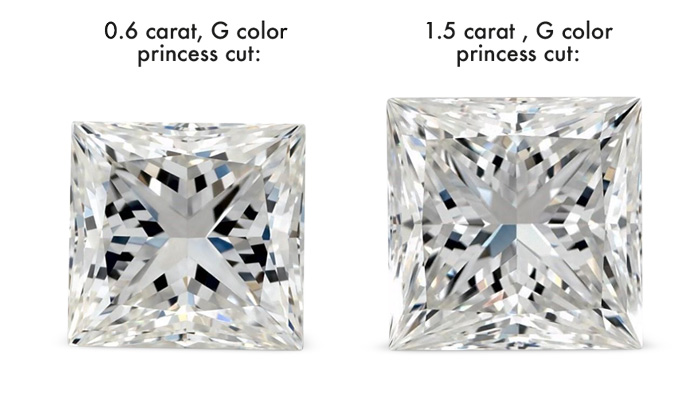
G color Cushion diamond
The cushion cut diamond is also a square cut diamond, but its corners are softly rounded making it resemble a pillow. The cushion cut is a modern take on a very old cut called an ‘old mine,’ which was extremely popular in the 1800s.
Cushions have a chunkier look to them. Since they are a distant relative of the modern round brilliant cut, they sparkle almost as much as the round meaning that a G color diamond will look colorless.
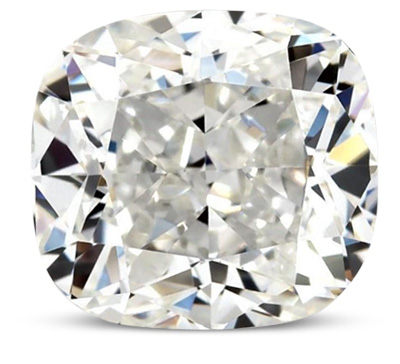
G color radiant diamond
A radiant cut diamond is a usually a rectangular cut diamond, but it can also be cut to be square – it all depends on what shape the original rough diamond crystal was.
The important aspect of the radiant is that its corners are beveled off, [AS1] distinguishing it from the princess cut and the cushion cut. The beveled corners give the diamond a sharper look than the cushion cut, but without the sharp angularness of the princess cut, which provides less opportunity for warmer tones to pool together. The radiant has a nice sparkle to it so it can mask some body color. A G color grade is a perfect grade for a radiant.
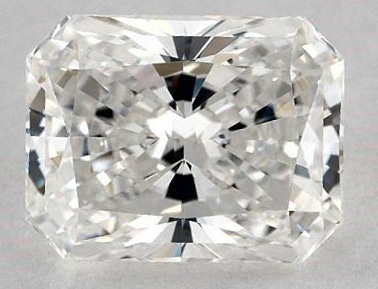
G color pear diamond
A pear cut diamond is a tear drop shape. It can be difficult to find a “just right” pear shape. Some are too fat making the tip of the tear drop less prominent. Other times, the pear is too thin. This balance of proportions is called the ‘length to width ratio.’ Review the diamond’s measurements and divide its length by its width to find the length to width ratio. A pear with a length to width ratio of 1.55 to 1.75 is where you want to be.
As with other shapes with a point, color has a tendency to pool at the tip of pear diamonds. This is especially noticeable in thinner pear diamonds. As you can see from the example below, the warmer tones are easier to pick up in the thinner pear. G can be a good color for a pear diamond if the stone isn’t too thin and doesn’t display the warmer color like the example below, which is also a good example of how color can pool at the tip.
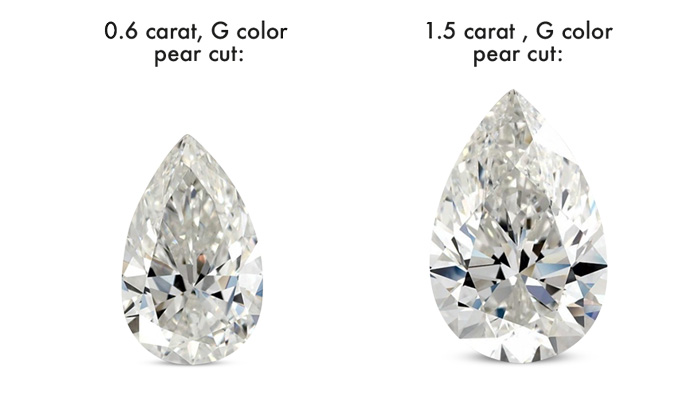
G color asscher cut diamond
While the other cuts we’ve looked at so far have been ‘brilliant’ cut, with their angles optimized to reflect light and sparkle, the asscher has a square ‘step’ cut. This means that it has longer and flatter surfaces, which mean that it reflects light differently than a brilliant cut diamond. Asscher cut diamonds reflect light from the surface of the stone as large glints of light rather than the rainbow dispersion of a brilliant cut.
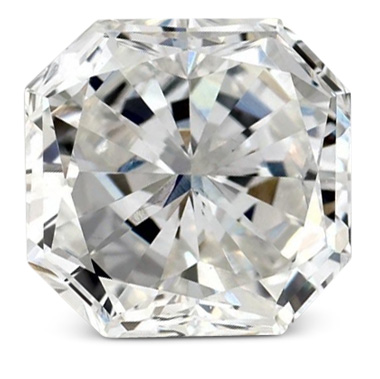
The step cut provides a window allowing the viewer to see into the depths of the diamond, and as a result doesn’t hide any body color in the diamond. A G color grade is still a good choice for an asscher cut, but you could see yellow if you move to an H color grade. In comparison, the warmth of a I or J will be readily visible in an asscher cut.
G color Emerald diamond
The emerald cut diamond is also a step cut diamond. It resembles the asscher cut but is rectangular instead of square. Also, like the asscher, the emerald cut will not hide yellow body color. A G color emerald cut diamond is a safe bet though and will look white once mounted in a setting. An I color grade is on the cusp of being visibly yellow and a J color grade in an emerald cut will be noticeably warmer.
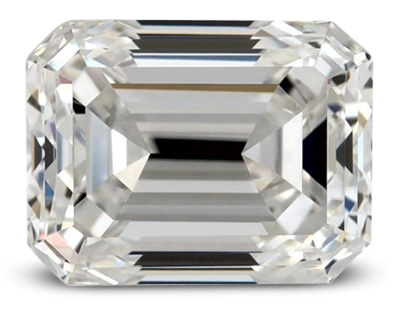
G color Heart diamond
Hearts are usually cut from very misshapen rough diamond crystals and are tough to fashion, so they are pretty rare.
As heart isn’t a common shape, it can be difficult to find a good one, and care should be taken when choosing proportions and shape. It may sound obvious, but the key to getting a beautiful heart diamond is making sure the heart actually looks like a heart shape. Some heart diamonds are cut fatter, without a clear definition on the top two lobes and a bottom point that isn’t defined. Diamond cutters do this to maximize the carat weight of the diamond and therefore how much they can sell it for.
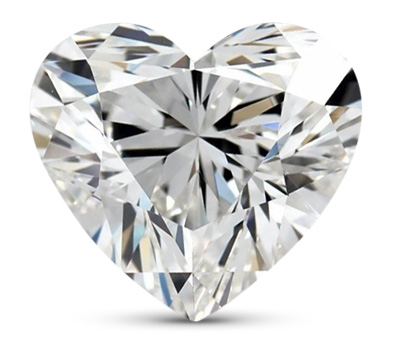
When purchasing a heart shape, defer to the shape over the color grade. I’d recommend a well-proportioned H color heart diamond over a poorly-cut G color heart any day. If you can find a balance of both though, a G color heart shape will face up beautifully white.
G color Marquise Diamond
The marquise cut diamond is shaped like an American football – it’s rounded on the sides and pointed at both ends. Because of this elongated shape, the marquise cut has a tendency to appear larger than other diamond shapes – bonus!
Even though there may be some color pooling at the tips, the brilliant cut of the marquise can mask a warmer body color. A G color would look very white as a marquise cut.
Marquise cut diamonds aren’t particularly fashionable at the moment, which means that they are often priced lower than other diamond shapes.
Where to buy G color diamonds
G color diamonds are a popular choice, so reputable brick and mortar jewelry stores should have a large selection of G colored diamonds in various shapes, carat weights, and clarity grades to review and choose from.
But, once you know it’s there, it can be tricky to still choose that stone.
I am a big advocate of buying diamonds and engagement rings online, due to the huge choice available to select from, the lack of sales pressure and the greater value for money that online retailers offer.
Online retailers extend this with a limitless selection of diamonds to compare and select from. James Allen alone has over 19,000 G color round brilliant diamonds in its inventory, meaning that you should be able to find the perfect diamond for you.
Check out my recommended retailers to find the retailer that is right for you.
